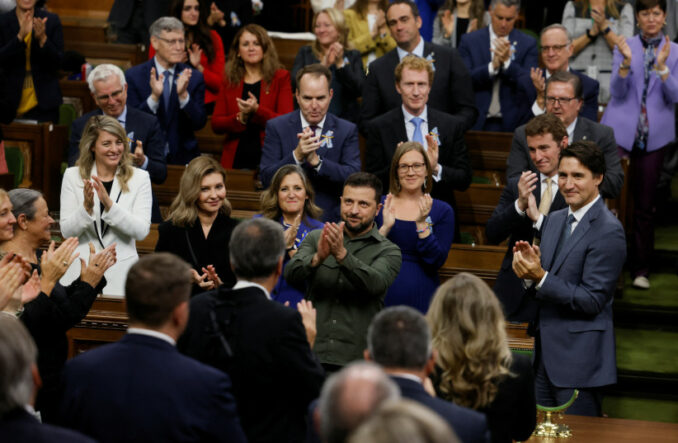Canadian Parliament applauds Nazi war criminal

Canadian Prime Minister Justin Trudeau and Ukrainian President Volodymyr Zelensky join in standing ovation to Nazi war criminal Yaroslav Hunka on Sept. 22, 2023.
In an appalling display, the Canadian Parliament gave a unanimous standing ovation to 98-year-old Nazi war criminal Yaroslav Hunka on Sept. 22. The disgraceful honor came shortly after Ukrainian President Volodymyr Zelensky delivered a speech to the House of Commons in Ottawa in which he desperately urged them to continue providing financial and military support to the proxy war in Ukraine.
Photographs show that every person in attendance, regardless of their political affiliation, stood up to applaud. Zelensky, who was giddy over the recognition,stood next to Canadian Prime Minister Justin Trudeau as everyone clapped and cheered.
Following Zelensky’s speech, House Speaker Anthony Rota gave a glowing introduction to Hunka, calling him “a war hero.” Rota said: “We have here in the chamber today a Ukrainian-Canadian veteran from the Second World War who fought for Ukrainian independence against the Russians and continues to support the troops today, even at his age of 98.” (Politico, Sept. 24)
After the parliamentarians gave Hunka a standing ovation, he saluted in response. According to media reports, the war criminal was a member of the First Ukrainian Division, known as the Waffen-SS Galicia Division, a voluntary military formation of Nazi Germany. (Guardian, Sept. 25) Radio Canada reports that the country permitted 2,000 soldiers from the fascist unit to relocate there. (Guardian, Sept. 27)
Rota neglected to point out that Russia and Ukraine were two of 15 republics that were part of the former Soviet Union, and Canada was in an alliance with the USSR during that war. And while most Ukrainian citizens sided with the Soviet Union’s Red Army against European fascism during World War II, a small minority of Ukrainian nationalists collaborated with the Nazis.
Initially, the corporate media was silent about this outrageous incident in the Canadian Parliament, but the story quickly spread online and throughout social media. Following a loud outcry from survivors and relatives of Holocaust victims, Jewish organizations, anti-hate groups and others, Rota resigned as House Speaker on Sept. 26.
Rota claimed full responsibility for the invitation and award, but many find it hard to believe that he acted alone in saluting an actual Nazi. Trudeau denies that neither he or his staff had any prior knowledge of either the invitation or the honoring of Hunka, but several parliamentarians question this assertion.
Some of the most brutal Nazi murderers who fled to North and South America to avoid prosecution following World War II were from Ukraine.
Nazis keep showing up in Ukraine
The National Endowment for Democracy backed the “Orange” color revolution in 2004 in Ukraine, which coincided with the election of Viktor Yushchenko to the presidency. This opened the door for far-right activity in that country. Not long after Yuschenko was elected, he campaigned to make controversial World War II-era Ukrainian nationalist leaders, such as Stepan Bandera and Roman Shukhevych, nationally recognized “Heroes of Ukraine.”
These Ukrainian nationalists fought against the Soviet Union and its allies. Bandera was a leader of the pro-fascist Organization of Ukrainian Nationalists (OUN) and Shukhevych spearheaded an anti-communist militia known as the Ukrainian Insurgent Army (UPA).
The 2013-2014 “Maidan” coup, which led to the violent overthrow of Yuschenko’s democratically elected successor, Viktor Yanukovych, would not have been possible without the presence of neo-Nazi gangs such as Right Sector, C14 and Carpathian Sich. Many Maidan supporters were photographed holding pictures of Bandera and waving OUN flags, along with Nazi and Confederate flags. The Azov Battalion was created as a neo-Nazi paramilitary outfit in May of 2014, and it spread like a cancer throughout the Ukrainian military and police.
As a result of Azov’s strong influence among the Ukrainian military, pictures continue to surface of Ukrainian soldiers wearing pro-Nazi patches, such as the infamous “Black Sun,” SS Bolts and swastikas, on their uniforms. Many soldiers have been spotted sporting pro-Nazi tattoos, which was noted in a June 7 New York Times article entitled “Nazi Symbols on Ukraine’s Front Lines Highlight Thorny Issues of History.”
One such thorny issue is the participation in the Zelensky regime of Ukrainian ultra-nationalist organizations with historic ties to those forces that fought on the side of Hitler’s Germany during World War II. The scandal in the Canadian Parliament shone a spotlight on the current role of these neo-Nazis in Kiev.

